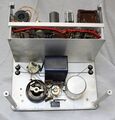1604-B: Difference between revisions
Jump to navigation
Jump to search
No edit summary |
No edit summary |
||
| Line 15: | Line 15: | ||
The General Radio 1604-B Comparison Bridge was introduced in 1954 Catalog N and remained available through Catalog O 1956. | The General Radio 1604-B Comparison Bridge was introduced in 1954 Catalog N and remained available through Catalog O 1956. | ||
The Type 1604-B was designed for sorting, adjusting and comparing two devices at three different frequencies. | The Type 1604-B was designed for sorting, adjusting and comparing two devices at three different frequencies. | ||
Impedance difference is measured in two ranges, 5% or 20% selected by a front panel switch, using a built generator and detector equipped with a 2AP1 CRT. | |||
A balance is achieved when the vertical deflection is at a minimum. | |||
Dissipation factor difference is read directly from the dial in one range. | |||
The main change from the [[1604-A]] is the addition of a 400 Hz test frequency. | |||
==Specifications== | ==Specifications== | ||
Revision as of 02:38, 16 March 2024
The General Radio 1604-B Comparison Bridge was introduced in 1954 Catalog N and remained available through Catalog O 1956.
The General Radio 1604-B Comparison Bridge was introduced in 1954 Catalog N and remained available through Catalog O 1956. The Type 1604-B was designed for sorting, adjusting and comparing two devices at three different frequencies.
Impedance difference is measured in two ranges, 5% or 20% selected by a front panel switch, using a built generator and detector equipped with a 2AP1 CRT. A balance is achieved when the vertical deflection is at a minimum.
Dissipation factor difference is read directly from the dial in one range. The main change from the 1604-A is the addition of a 400 Hz test frequency.
Specifications
- Deviation Range: Impedance difference, ±5% and ±20%, switched. Disipation factor difference, ±.006 at 400 Hz. ±.015 at 1 kHz. ±.075 at 5 kHz.
- Test Frequency: 400 Hz, 1 kHz, and 5 kHz; The frequency is within ±3% of the nominal value.
- Voltage Applied to Unknown: Approximately one volt, for impedances above 500 Ω. For lower values of impedance the voltage is decreased.







